The Tentipi Olivin 2 CP is the smallest cotton/polyester tipi from this Swedish tentmaker. Is it as good as its bigger brothers and sisters? Watch the review!
- Weight 5796,9 grams
- Pack size 28 cm x 49 cm
- Price € 699,00
There is nothing I can do about it, but I love tipi’s. Tipi’s are most of the time easy to pitch, they are sturdy, they are spacious, they have a unparalleled space to weight ratio, with the cotton/polyester they breath but still are waterproof and I can put my stove in them and have a nice fire when it is colder. This makes camping fun. Big time! I’ll say it again: I love tipi’s. And in this review, you should be aware of this.
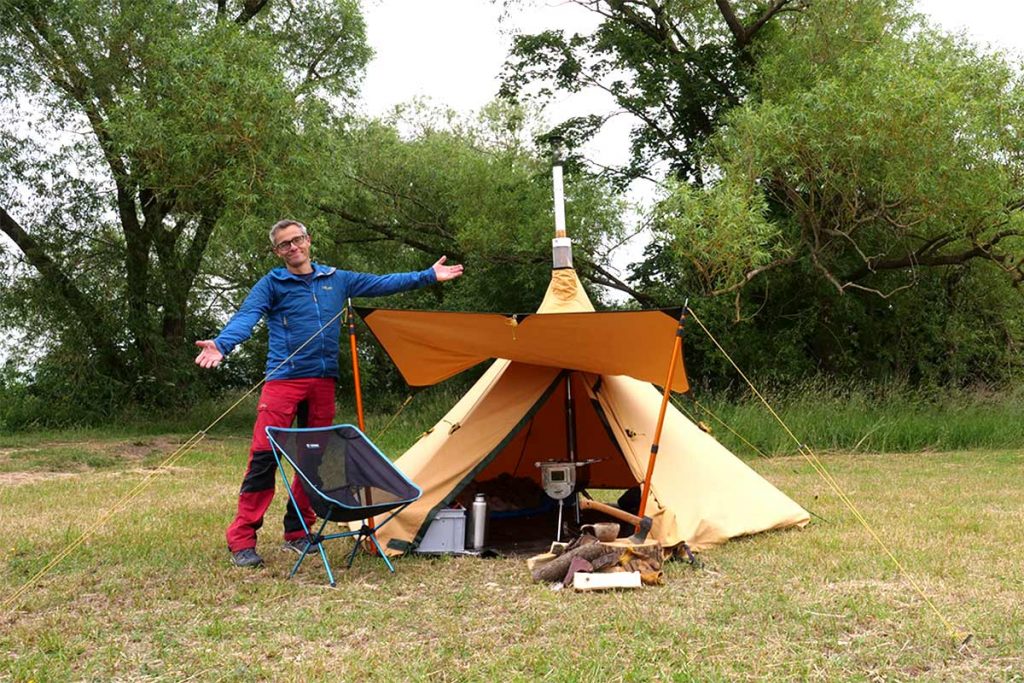
Size, weight and materials
The Tentipi Olivin 2 CP is the smallest cotton/polyester tipi within the Tentipi brand. But the 2 CP has two brothers or sisters: the Tentipi Olivin 2 Combi Light and the Olivin 2 Light. To be honest: both are the same but the first is with the included inner tent and the latter is without. Both are made of a ripstop polyamide with a silicone coating on both sides. I did a full review on this tent too so if you are interested, follow the link. The biggest difference between the 2 CP and the Light versions is the fly fabric and therefor the weight.
On my precise scale I weigh the Tentipi Olivin 2 CP at 5796,9 grams and that is almost double the weight of the Tentipi Olivin 2 Combi Light (3481 grams) I tested earlier. Not comparable of course since the Tentipi Olivin 2 CP comes without an inner tent. The weight is divided between the tent at 4150.3 gr, the pegs at 191.4 gr, the floor at 636.5 grams. Although I don’t think the Tentipi Olivin 2 CP is a tent for backpacking or biking one can still divide the weight a bit. The pack size I measure is 28 cm x 49 cm. The packsack (201.0 gr) of the Tentipi Olivin 2 CP is spacious and has super compression straps. Both are made from cotton/polyester or – as Tentipi likes to name it – Cotpolmex C with a fabric weight of 285 g/m2.
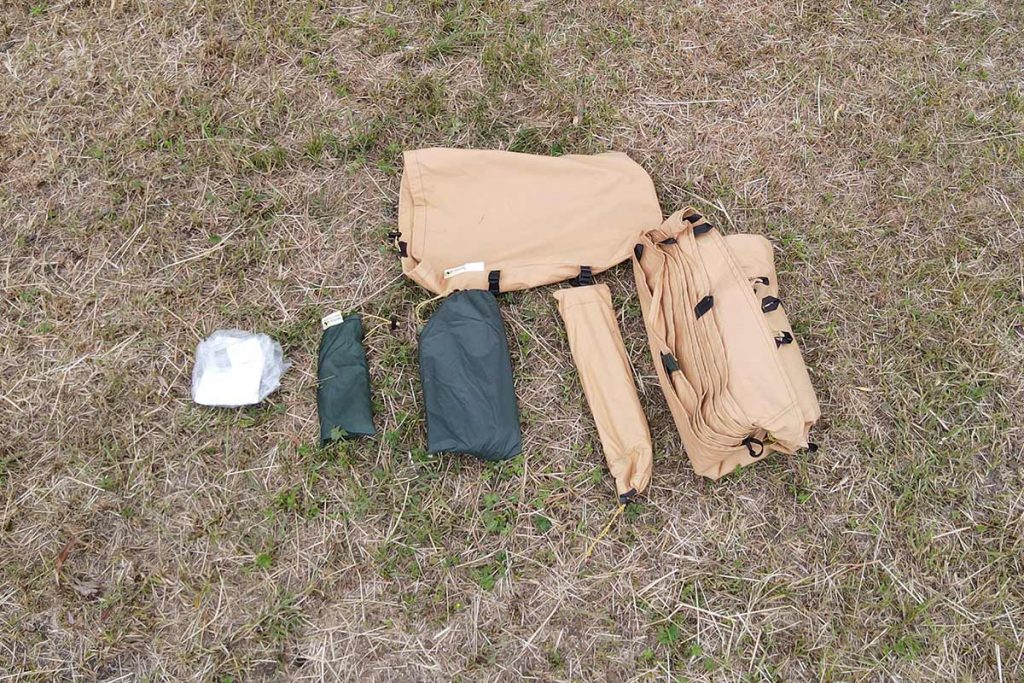
Instructions
One of the things I like about tipis is their simplicity and the manual that comes with the Tentipi Olivin 2 CP says it all. In A separate tube there is an instruction on a sort of scroll. It feels like going back in time. The instruction is not Olivin specific and applies to all Tentipi’s so sometimes things are a bit different and I need to use my brain. The manual is also provided on a USB stick so you can study at home.
Pitching Part I
The simplicity of all tipi’s – ok, not all – is that they have a base that is ‘round’. Depending on the size you need to place a number of pegs on certain places on that circle. To do this in a fast and simpel way, Tentipi has invented something clever. The tent is supplied with a measuring device. This tool is a fabric cloth with a kind of compass that gives the direction of all the pegs. Supplied is also a ribbon with a marking. The marking shows how far a peg should be placed from the middle of the tent. The middle being the spot where the pole goes. After placing al the pegs, pitching is just a matter of hooking all the loops of the tent on to the pegs.
Finally, just open the door, stick the pole in the tent and put it upright. Last but not least: place pegs for the guidelines. One small remark on the pegs. When using a hammer or an axe, hit the pegs with care. The aluminum pegs are strong, but with a hammer (or the back of an axe) you can easily ruin the head of the peg making it unusable. Better use a hiking boot. With the pegs in place, the tent is ready… or not? Shouldn’t there be a floor in the tent?
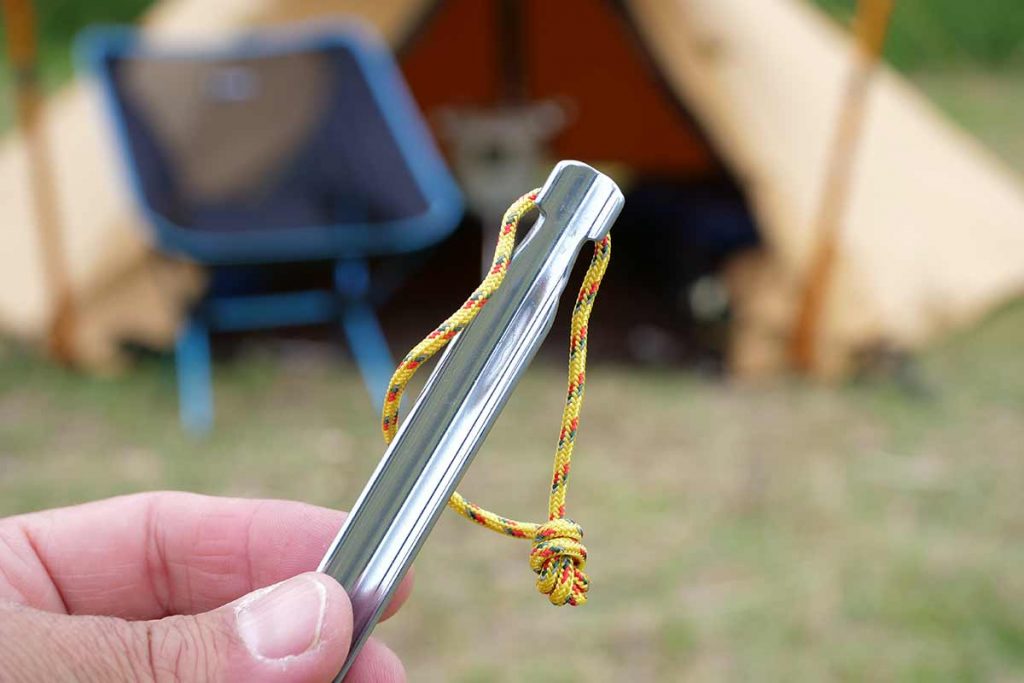
Chicken and eggs…
Now I have to talk about chicken and eggs… Was the egg first or the chicken? The chicken in this case is the tent. The egg is the floor. I prefer to pitch a tent first and put the floor in afterwards. Especially with rain this is the way to keep the floor dry and clean. But… connecting the loops of the floor to the pegs is less easy than I am used to from the bigger Tentipi’s. And it is different from the lightweight Olivin. The hardest thing is getting the toggles in the metal rings. It is a very tight fit and wit cold hands getting the toggles in the rings is a pain in the bum.
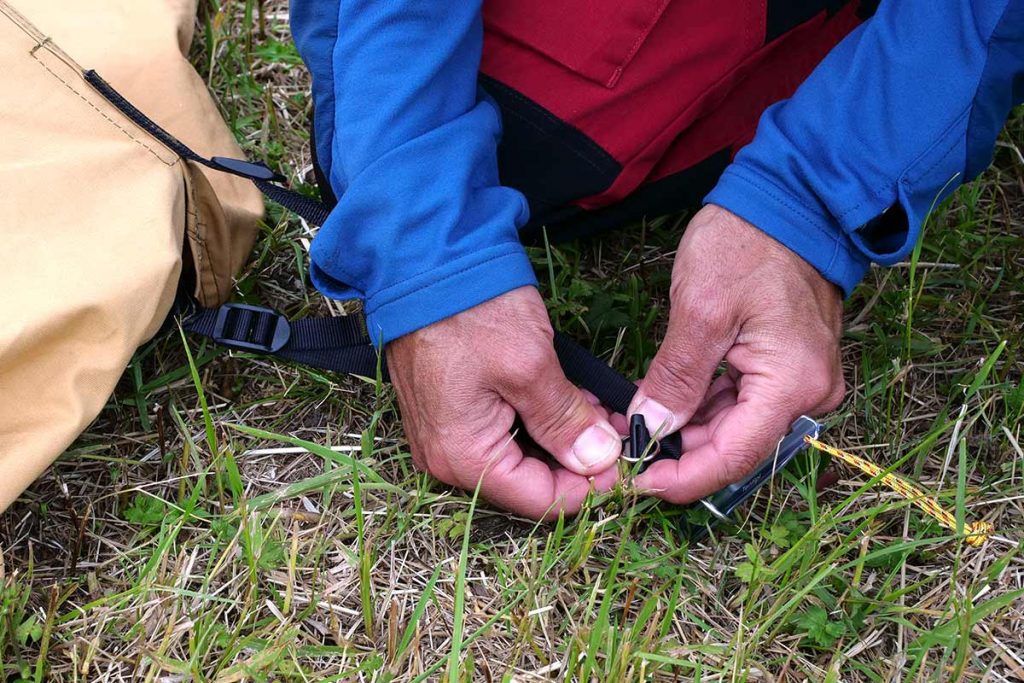
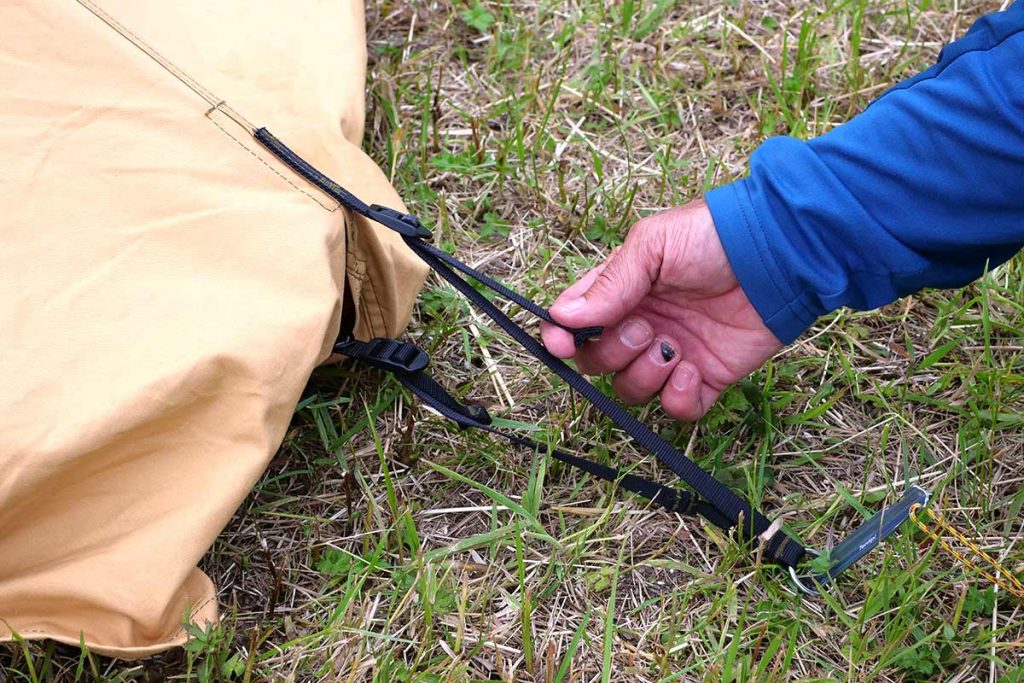
The straps of the tent are easy in use… 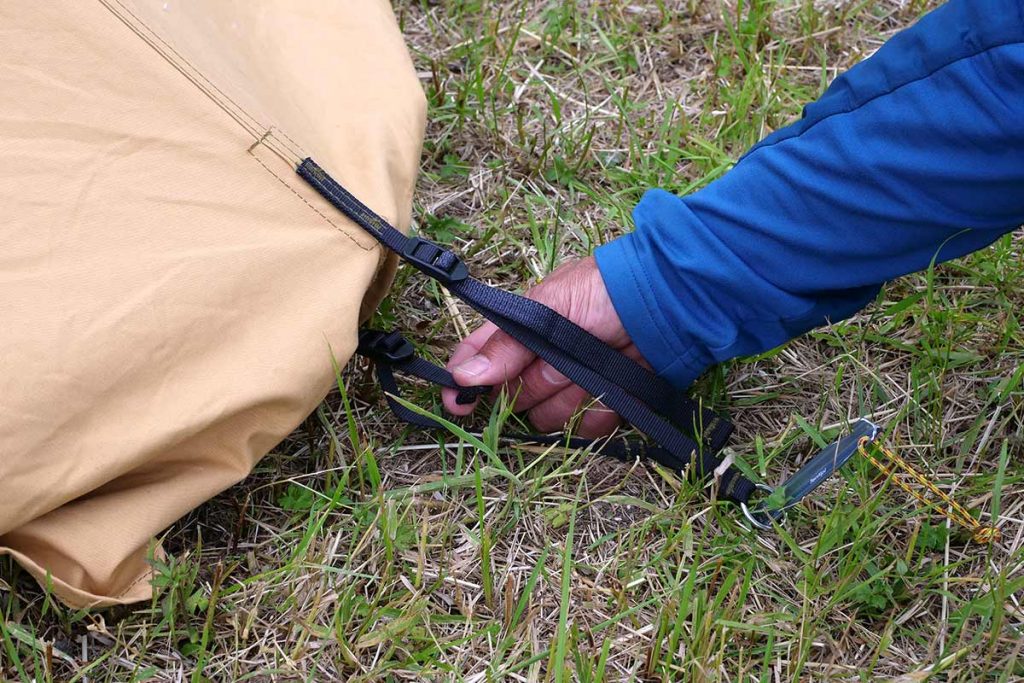
…the ones of the floor are sometimes hard to reach.
Pitching Part II
For so far, I have been doing everything that the manual that came with the tent tells me to do. But there is more than meets the eye. Pitching it this way results in an open circle of grass between the tent and the floor. This is due to the fact that the instruction shows the tent with the snow skirts in full glory pointing outwards. In not-winter circumstances – and especially in rainy conditions – the snow skirt should be pointing inwards.
It’s just a matter of tugging it under the floor and using some pegs to secure it. There is an update online on the Tentipi website in this. Just follow the link. Best use pegs with a rounded head since the pegs hide under the floor and with the provided Tentipi pegs you will hurt yourself and damage the floor. A pity these pegs are not provided with the CP 2. When attaching the floor this way you almost have a waterproof and bug free tent. One final remark on the floor/tent construction: I miss the toggle construction on the tent fabric in the corners when facing inwards. This construction is part of the bigger tents and makes the octagonal shape nicer and the ‘seal’ to the floor better.
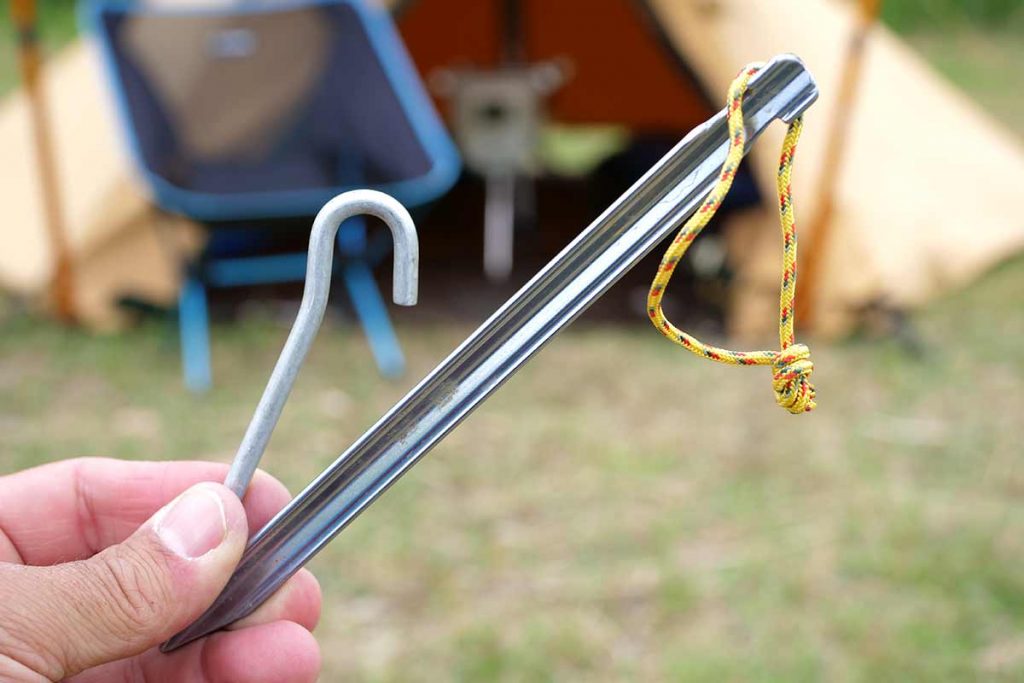
Living quarters
The Tentipi Olivin 2 series is designed for 2 adults and with a diagonal of 280 cm the space is fine. There is enough room for luggage in two big backbags or duffels. Or for panniers if you travel by bike or motorbike. And yes, some Rako boxes fit too. Be aware of the fact that if two adults want to sleep next to each other one of the two is tugged a bit in the tent fabric. And you will need to sleep on mattresses; there is not enough height for stretchers.
If you are a family with two small kids (or dogs) than there is just enough space, but the adults will need to sleep on either side of the pole each. The kids (or dogs) go each on one side of the parents. Nice and cozy. That this harms the luggage space inside should not be surprising. What I do like about the smallest Tentipi is the usable height of about 140 cm: with my 169 cm I can dress myself standing sort of upright. If you want to be 100% guaranteed bug-free, you can use the optional Olivin 2 innertent but the living space is smaller.

The guy-line storage is a piece of elastic band. 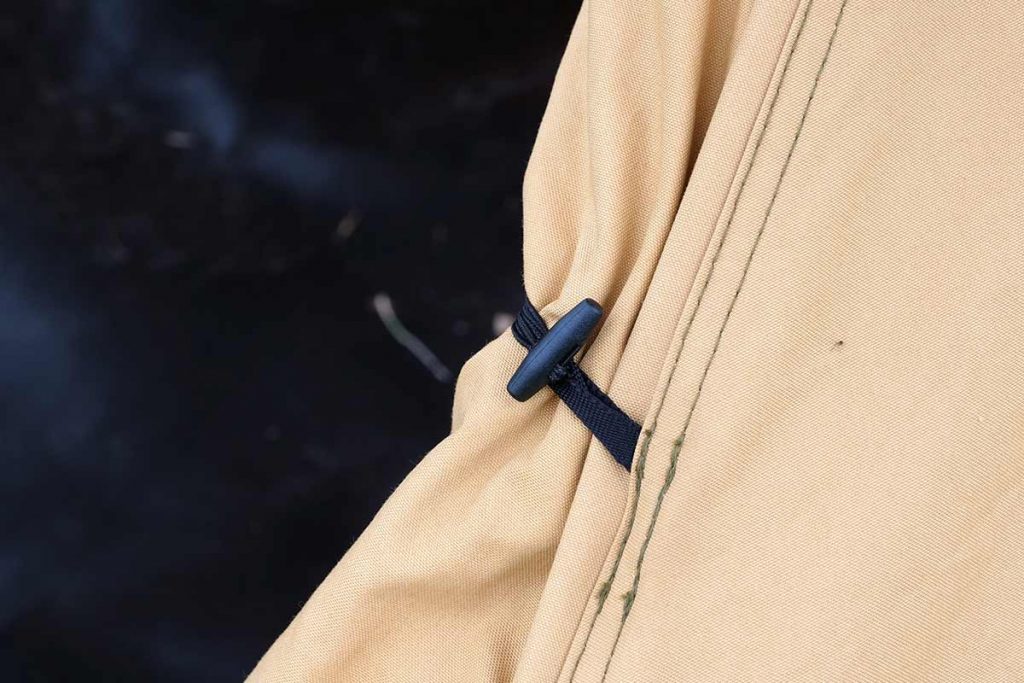
The door is fixated with a small toggle.
Four season tent
Like all cotton/polyester fabric Tentipis, the Olivin 2 CP is a tent to camp all year around. The big advantage of the cotton/polyester fabric is that is breathes. With the lightweight fabrics this is not the case. Because of this breathing through the fabric, the atmosphere inside the tent is very pleasant.
With colder weather the tent is warmer thanks to the thick fabric. Also, condensation is very little if any. The fabric breathes and there is a big ventilation opening (yes, also the chimney: more on this later) in the roof. One skirt of the CP 2 can be lifted and tied down with a toggle system to create a big ventilation opening. The two vents together create a nice low-high draft.
The Tentipi Olivin 2 CP is also a super performer with hot summer weather; it is way cooler than plastic tents. Again… ventilation and fabric. The door has a very large piece of mesh for ventilating (doubles as a window). If you camp near a stream it is even possible to cool down the tent with water from the stream. Poor water over the tent and the wet tent fabric immediately wants to dry and thanks to the process of evaporating the tent gets cooler.
Ventilator cap remote control
The top ventilation is quite something special. The ventilator cap can be opened in any direction by pulling strings on the inside of the tent. A sort of remote control. They are positioned next and on to the pole. For the small Olivins this is not really necessary since I can reach the ventilator cap by hand. With the bigger and higher Tentipi’s you need the strings. When using a stove, the strings are best hung to the side of the tent; otherwise they might get too hot. The bigger Tentipi’s have a special toggle for this on the tent but the CP 2 misses this one.
Because of this ventilator cap you can open the vent right in the wind or sheltered from the wind forcing wind in the tent or pulling air out the tent. This one also makes it possible to make a small open fire in the tent. Providing you are not using the floor. I would not advice it, but in case of emergency it can prove to be very needed.
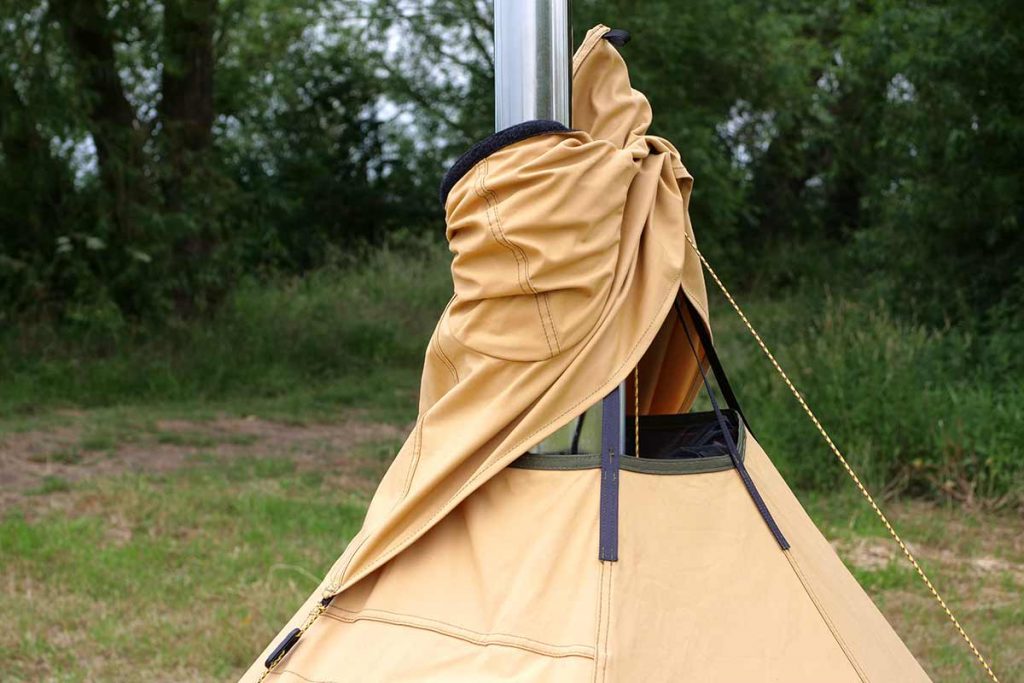
Stove and chimney
So, I think the Tentipi Olivin 2 CP is a four-season tent. What about winter? Well… For real harsh winter conditions, the CP2 is equipped with snow skirts but the real sweet thing is that I can use a small stove in the tent also. The ventilation-opening in the roof has a special chimney outlet pipe for a stove. This outlet looks a bit like a sleeve and fits snug around the double walled piece of pipe that I use. I tested the CP 2 with a Winnerwell Woodlander Medium (Review coming up) that I borrowed from the Dutch distributer. I placed the stove in front of the pole with the opening facing the entrance.
The CP 2 floor has a large piece of Velcro so I can take away this piece and place the stove on the grass. In this way no sparks falling from the stove when I open the door can ruin the floor and tent. But… I used a Winnerwell Fireproof Mat under the stove against falling sparks. Way better! Off course you should be careful with a small tent and a stove in it, but it works. In wintertime the small tent takes little time to heat. On the stove I can cook, boil water and dry the tent in the morning if I want to move elsewhere.
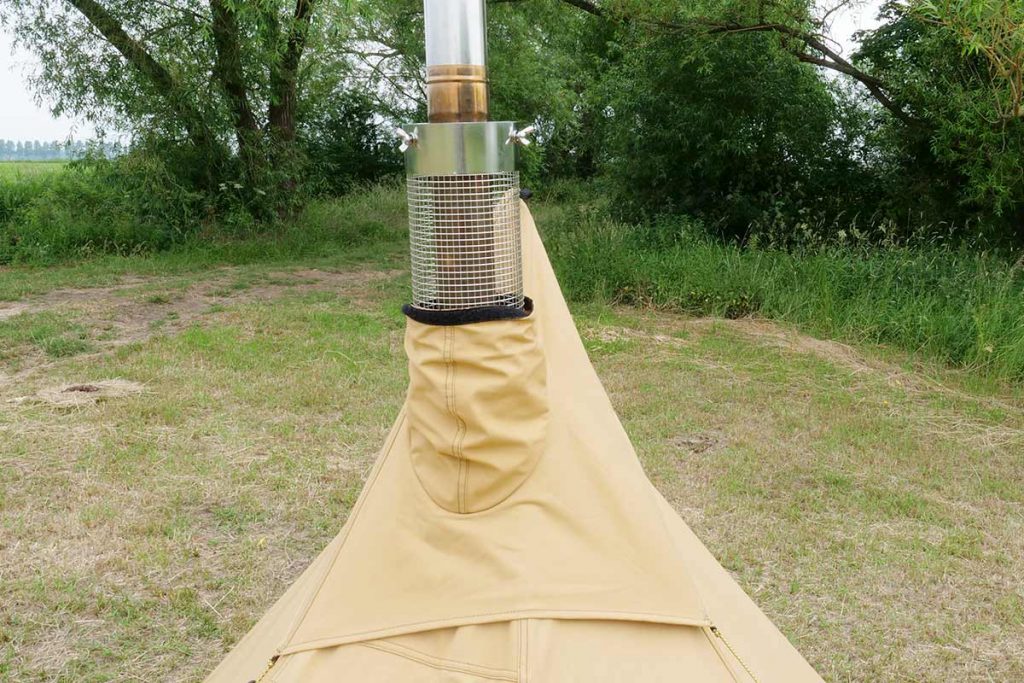
The ventilator cap in use with the mesh double pipe. 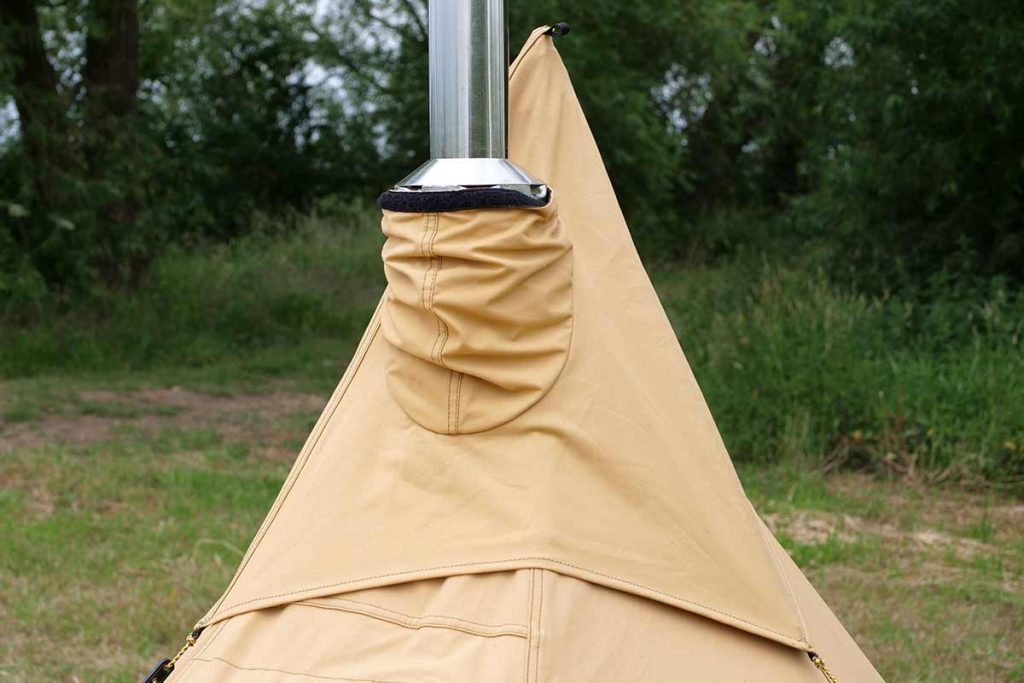
The ventilator cap outlet and the double walled pipe.
WARNING
This is the first time that I feel I have to write a warning for a tent. And it has to do with the stove. As stated above I used a Winnerwell Woodlander Medium. This is the smallest stove I could lay my hands on that fitted the tent and the Æ13 cm chimney outlet. I used a Winnerwell double walled piece of pipe on the part where the chimney goes through the fabric. The temperature I measured of the metal where it touches the fabric and it ranges between 35 and 90 degrees Celsius. I don’t know what to think of this. The tent fabric show’s no damage, but I don’t feel comfortable about this.
The real bad thing is that Tentipi states on the website that the chimney opening is for a ‘Micro stove’ but they fail to state what a micro stove is. Also Tentipi Eldfell stoves are not small and I would never use one of them in this tent. My advice is: if you want to use a stove, use it gently and don’t try to heat it to red glowing metal. Good news: Winnerwell is making a Winnerwell Woodlander Small that will be available shortly and should be less powerful and therefor better for the CP 2. Update will follow.

The practice
The Tentipi Olivin 2 CP has been with me since it was introduced on the Scandinavian Outdoor Awards in June 2019. It went with us for a month on our family camping trip in Sweden. In everyday camping life the tent has proven to be easy to pitch and pack. The space in the tent is adequate. Getting in the tent with the stove in front of the pole is something you have to do very careful.
As mentioned above already: climate in the tent is superb and, in this respect, ‘cotton’ tents are hard to beat anyway. The ventilation is super and the system to operate the ventilator cap is very user-friendly and it is resistant to a lot of wind and rain and there is no leakage. The only negative remark is the floor of the CP 2.
With bad weather and wet grass the floor is not waterproof. In the morning it happened several times that the floor underneath the mattresses was wet. This has maybe to do with condensation from body warmth, but this is not the case. Under the Winnerwell Fireproof Mat the floor was wet to. The solution is an extra piece of cheap DIY plastic under the floor but that is stupid of course. The floor should be waterproof.
What I also miss on the CP 2 is a reinforced edge, the spot where the tent touches the ground. Some series Tentipi’s – like the Safir I reviewed – have this piece of non-cotton fabric around the tent. It prevents that the edge is soaked in wet grass all the time. This is not good for the fabric. After a few wet days I notice that the edge gets very dirty and wet.
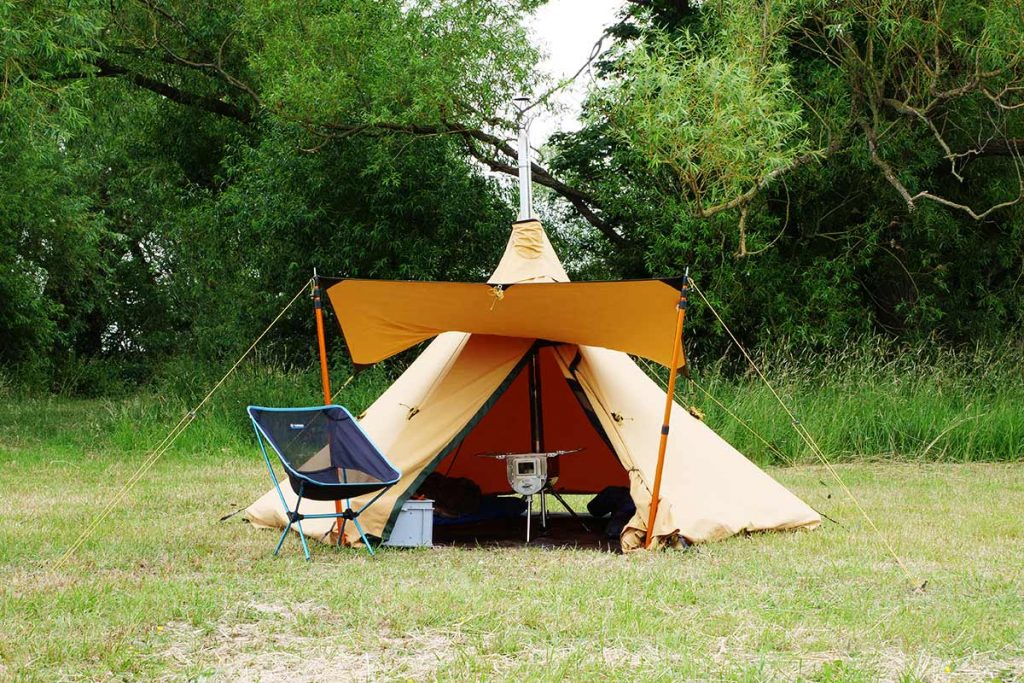
Talking about waterproofness… one of the downsides of a tipi – any tipi – is that the entrance is not sheltered from wind and rain. Open the door when it rains, and rain immediately gets in the tent and that is not pleasant. But there is a solution.
Canopy
Just above the entrance there is a piece of Velcro where I can attach the special Tentipi canopy. The canopy (769.4 grams and pegs 101.8 gr, Packsize 12 x 36 cm) is made of the same fabric as the tent and has 5 guy lines. I used some extra tent poles but you can use trekking poles as well. Fitting is easy and the extra protection super. If you plan to buy a Tentipi… think about buying the canopy too; it makes tent life way better.

Verdict
If you have seen – or read – my other Tentipi reviews, you will understand that I love them and that I embrace the tipi as a wonderful tent concept. But… as you might have noticed – I am not totally convinced with the 2-person Tentipi Olivin 2 CP. The tent does almost everything that the bigger Tentipi’s also do and the typical ‘tipi-feeling’ is there. It is cozy, it is warm if you want it to be warm and cool if you want it to be cool, the tent fabric has proven to be waterproof and the CP 2 is very wind resistant. And for Star Wars lovers like I am, the name is even sort of R2D2 cute. But there are just too many small details that just don’t add up.
I miss the much-needed details that I do find in the bigger Tentipi’s. A toggle on the side to get the remote control for the ventilator cap out of the way of a hot chimney, is just one of them. The fact that the floor is not waterproof, that it has no reinforced edge and the use of a stove inside a very small tent… I am not convinced except for real harsh winter conditions. So, for me it is not as usable throughout the year around as is the case with the bigger Tentipi’s.
The weight of almost 6 kg and the rather large pack volume make it more of a car/motorcycle tent than a trekking tent like the small Olivin 2 Lightweight version. The price of € 660,00 is not too bad and I would add the canopy at € 110,00 for a better overall experience. But for € 200,00 more and 1.5 kg extra one buys the Tentipi Onyx 5 CP. A way bigger and more versatile tent. I know what I would do… I rate the Tentipi Olivin 2 CP at 7.0/10 points.
Information
- The Netherlands: www.moosecamp.nl
- International: www.tentipi.com
